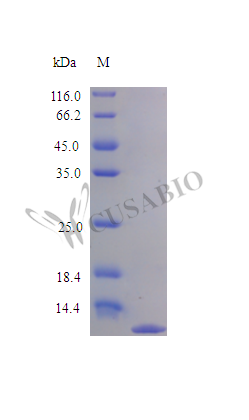Recombinant Human Tumor necrosis factor receptor superfamily member 12A protein (TNFRSF12A) is expressed in E. coli and spans the 28-80 amino acid region. This tag-free protein is available at a high purity of over 95%, confirmed by SDS-PAGE analysis. It exhibits full biological activity, with an ED50 of less than 30 ng/ml in inhibiting TWEAK-dependent proliferation of HUVECs. The endotoxin level is maintained below 1.0 EU/µg, ensuring suitability for research applications.
TNFRSF12A belongs to the tumor necrosis factor receptor superfamily and appears to play a critical role in cellular signaling pathways. The receptor is involved in processes such as cell proliferation and survival, particularly in response to the ligand TWEAK. As researchers work to understand inflammatory and immune responses, TNFRSF12A has emerged as a valuable target for investigating cell signaling and therapeutic development.
Potential Applications
Note: The applications listed below are based on what we know about this protein's biological functions, published research, and experience from experts in the field. However, we haven't fully tested all of these applications ourselves yet. We'd recommend running some preliminary tests first to make sure they work for your specific research goals.
1. TWEAK-TNFRSF12A Interaction Studies
This recombinant TNFRSF12A protein is confirmed to be biologically active as a TWEAK antagonist (ED₅₀ < 30 ng/ml in HUVEC proliferation inhibition) and suitable for interaction studies. However, the partial sequence (28-80aa) may not fully represent the extracellular domain of the full receptor, potentially affecting binding kinetics and stoichiometry. While the demonstrated antagonistic activity confirms functional TWEAK binding, quantitative binding assays should be validated against full-length TNFRSF12A to ensure accurate affinity measurements.
2. Endothelial Cell Function Research
The protein is appropriate for studying TWEAK-mediated endothelial responses, but researchers should note it functions as a TWEAK antagonist rather than an agonist. Applications should focus on inhibiting TWEAK-induced angiogenesis, proliferation, or inflammation rather than mimicking receptor activation. The ED₅₀ provides a reliable reference for dose-response studies, but optimal concentrations may need adjustment for different endothelial cell types or functional readouts beyond proliferation.
3. TWEAK Pathway Antagonist Development
This protein serves as an excellent positive control for TWEAK inhibition studies. The well-characterized antagonistic activity (ED₅₀ < 30 ng/ml with 15 ng/ml TWEAK) makes it suitable for benchmarking novel inhibitors. However, the partial sequence may have different pharmacokinetic properties than full-length receptor or small molecule inhibitors, which should be considered when extrapolating to therapeutic development.
4. Antibody Development and Validation
This high-purity TNFRSF12A fragment serves as a good antigen, but antibodies generated against this partial sequence (28-80aa) may not recognize epitopes in other receptor domains. Comprehensive antibody validation should include testing against full-length TNFRSF12A, particularly for applications requiring detection of the native membrane-bound receptor. The antagonistic function supports the development of blocking antibodies.
5. Cell Signaling Pathway Analysis
The protein is suitable for studying TWEAK pathway inhibition, but researchers should distinguish between direct receptor signaling (which requires a membrane-anchored full-length receptor) and decoy receptor function (which this soluble fragment provides). This fragment primarily acts as a decoy inhibitor rather than initiating signaling, making it ideal for studying TWEAK sequestration effects but not receptor activation pathways.
Final Recommendation & Action Plan
This recombinant human TNFRSF12A partial protein (28-80aa) is a validated TWEAK antagonist suitable for most proposed applications with appropriate consideration of its decoy receptor function. For immediate use, employ it at 10-100 ng/ml for TWEAK inhibition studies, using the established ED₅₀ as a reference point. When studying TWEAK interactions, focus on competitive binding applications rather than receptor activation signaling. For antibody development, this fragment is ideal for generating function-blocking antibodies targeting the TWEAK-binding domain, but validated against the full-length receptor for comprehensive epitope coverage. The E. coli expression produces a non-glycosylated protein, which may affect stability but not core TWEAK-binding function based on the demonstrated bioactivity. Always include proper controls (TWEAK alone, fragment alone) and consider that different cell types may exhibit varying sensitivity to TWEAK pathway modulation. For signaling studies, use this protein specifically for TWEAK sequestration experiments rather than receptor activation models.




